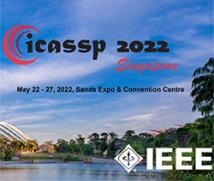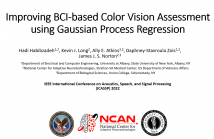
ICASSP 2022 - IEEE International Conference on Acoustics, Speech and Signal Processing is the world’s largest and most comprehensive technical conference focused on signal processing and its applications. The ICASSP 2022 conference will feature world-class presentations by internationally renowned speakers, cutting-edge session topics and provide a fantastic opportunity to network with like-minded professionals from around the world. Visit the website.

- Read more about Joint Speech Recognition and Audio Captioning
- Log in to post comments
Speech samples recorded in both indoor and outdoor environments are often contaminated with secondary audio sources. Most end-to-end monaural speech recognition systems either remove these background sounds using speech enhancement or train noise-robust models. For better model interpretability and holistic understanding, we aim to bring together the growing field of automated audio captioning (AAC) and the thoroughly studied automatic speech recognition (ASR). The goal of AAC is to generate natural language descriptions of contents in audio samples.
- Categories:
 12 Views
12 Views
- Read more about Improving Feature Generalizability With Multitask Learning In Class Incremental Learning
- Log in to post comments
- Categories:
 70 Views
70 Views
- Read more about Improving Feature Generalizability With Multitask Learning In Class Incremental Learning
- Log in to post comments
- Categories:
 9 Views
9 Views
- Read more about Model-Based Reconstruction for Collimated Beam Ultrasound Systems
- Log in to post comments
Collimated beam ultrasound systems are a novel technology for imaging inside multi-layered structures such as geothermal wells. Such systems include a transmitter and multiple receivers to capture reflected signals. Common algorithms for ultrasound reconstruction use delay-and-sum (DAS) approaches; these have low computational complexity but produce inaccurate images in the presence of complex structures and specialized geometries such as collimated beams.
ICASSP2022.pdf
- Categories:
 4 Views
4 Views
- Read more about FilterAugment: An Acoustic Environmental Data Augmentation Method
- Log in to post comments
Acoustic environments affect acoustic characteristics of sound to be recognized by physically interacting with sound wave propagation. Thus, training acoustic models for audio and speech tasks requires regularization on various acoustic environments in order to achieve robust performance in real life applications. We propose FilterAugment, a data augmen-tation method for regularization of acoustic models on vari-ous acoustic environments.
- Categories:
 20 Views
20 Views
- Read more about Direct Localization: An Ising Model Approach
- Log in to post comments
Accurate indoor localization is a challenging problem in a multipath environment. In order to tackle this problem, several methods have been proposed. Direct localization is one of these methods that makes use of a two-dimensional search in a planar geometry. In this paper, we use a compressed sensing framework in the direct localization technique to estimate the location of a user in an indoor multipath environment. We form a penalized `0-norm structure for this problem, and then convert this structure to an Ising energy problem.
- Categories:
 14 Views
14 Views
- Read more about NEAREST SUBSPACE SEARCH IN THE SIGNED CUMULATIVE DISTRIBUTION TRANSFORM SPACE FOR 1D SIGNAL CLASSIFICATION
- Log in to post comments
This paper presents a new method to classify 1D signals using the signed cumulative distribution transform (SCDT). The proposed method exploits certain linearization properties of
- Categories:
 10 Views
10 Views
- Read more about INTERPRETING INTERMEDIATE CONVOLUTIONAL LAYERS IN UNSUPERVISED ACOUSTIC WORD CLASSIFICATION
- Log in to post comments
Understanding how deep convolutional neural networks classify data has been subject to extensive research. This paper proposes a technique to visualize and interpret intermediate layers of unsupervised deep convolutional networks by averaging over individual feature maps in each convolutional layer and inferring underlying distributions of words with non-linear regression techniques. A GAN-based architecture (ciwGAN [1]) that includes a Generator, a Discriminator, and a classifier was trained on unlabeled sliced lexical items from TIMIT.
- Categories:
 13 Views
13 Views
- Read more about Identification of Overlapping Echoes of Unknown Shape from Time-Encoding Machine Samples.
- Log in to post comments
We present an algorithm for the resolution of delayed and overlapping pulses of a common unknown shape from multi- channel measurements. We show that just a few Fourier sam- ples acquired by a Time Encoding Machine (TEM) suffice to solve this challenging problem. This acquisition scheme is desired for ultra-low power applications in wearables, such as EMG skin sensor tattoo.
- Categories:
 19 Views
19 Views
- Read more about Habibzadeh_ICASSP3270_poster
- Log in to post comments
We present metamer identification plus (metaID+), an algorithm that enhances the performance of brain-computer interface (BCI)-based color vision assessment. BCI-based color vision assessment uses steady-state visual evoked potentials (SSVEPs) elicited during a grid search of colors to identify metamers—light sources with different spectral distributions that appear to be the same color. Present BCI-based color vision assessment methods are slow; they require extensive data collection for each color in the grid search to reduce measurement noise.
- Categories:
 12 Views
12 Views